In China, clinicians are expected to publish a certain number of research papers in international journals if they want to be promoted. The easiest way is to pay a paper mill, which seem to provide a full service: an English-speaking research paper containing Photoshop-generated fake research data, in a respectable peer-reviewed journal, with your name on it. Entire journals published by Wiley or Elsevier succumb to such scams, presumably because certain corrupt editorial board members are part of it. This was uncovered in an investigation by Elisabeth Bik, as well as the pseudonymous Smut Clyde, Morty and Tiger BB8, and narrated below by Smut Clyde.
The presently almost 500 papers were traced to one specific paper mill not because of direct image reuse, but because the data showed same patterns of falsifications: same blot backgrounds, same shapes of bands, and similarly falsified flow cytometry plots.
The growing list of papers and affected journals is available here.
Apparently, the Chinese paper mills even handle submissions, peer review (if there is a peer review, that is) and sign the copyright consent forms while pretending to be the listed authors. This is evidenced by the fact that in some cases only bizarre Gmail addresses are provided for alleged corresponding authors in China. Gmail access, as all Google services, were blocked by the Great Chinese Firewall in 2014, on Party’s orders. It is theoretically possible to use Google via VPN, but the Party has criminalised this, so hardly anyone dares. Whoever answers the Gmail accounts like CaseyPeiffer8311@gmail.com is definitely not some doctor in China listed as paper’s author, but the paper mill operator.
The papers mills churning out masses of 100% fabricated, never performed science which only exists in Photoshop, are the secret of Chinese science output supremacy which we in the West so admire and strive to keep up with. Reality is: nobody cares if the published research is real, slightly falsified or entirely made-up. Fraudsters face little consequences if they are well-connected, and one can always denounce a western conspiracy. The good scientific practice lessons preached by Chinese science elites do not even apply to themselves, as the case of Xuetao Cao demonstrated.
The extra joke on top is that many of these fake paper mill emissions tout the alleged powers of Traditional Chinese Medicine (TCM) to cure cancer and other maladies, all because the nation’s President Xi Jinping himself is such a big fan of TCM. The Communist Party of China is merely getting what it ordered, again and again.
Maybe we in the West also should impose such idiotic laws? In fact, also in the “western” university hospitals, promotions depend on the publication record. So far, US, German and other doctors got ahead by gift authorships, self-plagiarism, and where needed, with outright plagiarism and falsified data. But actually, can we really be so sure that paper mills are an Asian phenomenon only?

When the count was at 320 (now almost 500), more than half of the mill papers came from the Shandong province, almost a fifth from Jilin and one tenth from Henan. This message was sent to Tiger BB8 by such a Chinese paper mill customer:
“Hello teacher, yesterday you disclosed that there were some doctors having fraudulent pictures in their papers. This has raised attention. As one of these doctors, I kindly ask you to please leave us alone as soon as possible.
Being as low as grains of dust of the world, countless junior doctors, including those younger me, look down upon the act of faking papers. But the system in China is just like that, you can’t really fight against it. Without papers, you don’t get promotion; without a promotion, you can hardly feed your family. I also want to have some time to do scientific research, but it’s impossible. During the day, I have outpatient surgeries; after work, I have to take care of my kids. I have only a little bit time to myself after 10 pm, but this is far from being enough because scientific research demands big trunks of time. The current environment in China is like that.
You expose us but there are thousands of other people doing the same. As long as the system remains the same and the rules of the game remain the same, similar acts of faking data are for sure to go on. This time you exposed us, probably costing us our job. For the sake of Chinese doctors as a whole, especially for us young doctors, please be considerate. We really have no choice, please!”
Tiger BB8 found out even more. There are actually even open online advertisement for authorships on artificially generated scientific papers:

Red box right, 1st bullet point: “multiple SCI manuscripts for sale. All written up. We will submit with your name on it.”
4th bullet point: “My lab has more SCI manuscripts for sale. Some have been reviewed and now under revision.”
But then again, not everyone buys fake papers from paper mills. What about these honest doctors who don’t, do their careers not count? And if doctors cheat in research, where else will they cheat to improve their performance statistics? Will fictional TCM papers lead to real patient therapies, a predictable public health disaster?
One journal particularly hit by an organised paper mill scam is the Journal of Cellular Biochemistry, published by Wiley. Its editorial board features many prominent US scientists, including the infamous Carlo Croce. For many years and up until mid-January 2020, the journal was run by an academic editor, the now 77-year-old Gary Stein. He stepped down, and the new temporary Editor-in-Chief is a Wiley employee Lucie Kalvodova. But when first concerns about falsified papers emerged, Stein wrote on 14 January 2020 to a whistleblower:
“Thank you for bringing these concerns to our attention. We will look further into the content of the article.“
In September 2019, Wiley opened a search for a new Editor-in-Chief, as referenced by this Chinese website. It makes sense: in recent journal editions, around 90% of papers have Chinese authors, as if there was some kind of pattern. Now Wiley announced to me to be investigating the goings-on at Journal of Cellular Biochemistry, and asked to share the list compiled by Bik and Smut Clyde. Also a Taylor & Francis publishing ethics manager was thankful and added:
“We’re looking into the affected articles as a matter of urgency.“
Update 28.01 and 6.02.2020. It is possible the paper mill is creating dud ORCID profiles for their customers, since some journals, like Journal of Cellular Biochemistry apparently expect ORCID identification. Smut Clyde collected a number of suspect cases, here some examples: Zhang et al 2018 and Zhang & Liu 2019 contain next to utterly phony Gmail addresses also empty ORCID profiles, created after the manuscripts were submitted (here and here).
Further evidence to ORCID fraud is provided by the fact that certain actors and recurrent paper mill customers sport multiple ORCID entries. A certain Yang Wang of Jilin University purchased 3 papers from the mill (Nr 17, 18 and 31 in the list), for which 2 ORCID ID were created (here and here). The duo Dexin Yin and Dajun Sun, also of Jilin, purchased 6 papers (Nr 40, 41, 70, 265, 273, 279), for which two throwaway ORCID profiles were created for each gentlemen (Yin vs Yin, Sun vs Sun). There are even different throwaway email addresses for the alleged corresponding authors, different in each Journal of Cellular Biochemistry paper:
- Yin: yindexin221@sina.com, mudanren8646ktd@163.com
- Sun: dajunsun0060@sina.com, sundajun0056@sina.com, sundajun221@sina.com
Here is the list again. There is also a pdf hosted by Elisabeth Bik, which is being regularly updated. The list presently contains
- 59 papers in Journal of Cellular Biochemistry, 16 in BioFactors, 25 in Journal of Cellular Physiology, 8 in Phytotherapy Research (Wiley);
- 52 in Biomedicine & Pharmacotherapy, 26 in Experimental and Molecular Pathology, 14 in Life Sciences, 9 in International Immunopharmacology, 4 in International Journal of Biological Macromolecules (Elsevier);
- 27 in Cellular Physiology and Biochemistry (Karger, now self–published);
- 5 in Molecular and Cellular Biochemistry, 4 in Journal of Physiology and Biochemistry, 8 in BMC Cancer (Springer Nature);
- 31 in Brazilian Journal of Medical and Biological Research (SciELO);
- 37 in Oncology Research (Ingenta);
- 12 in International Journal of Immunopathology and Pharmacology (SAGE);
- 5 in Cancer Biomarkers (IOS Press);
- 7 in Neoplasma (AEPress);
- 7 in European Review for Medical and Pharmacological Sciences (Verduci Editore)
- whooping 78 papers in Artificial Cells Nanomedicine and Biotechnology (Taylor & Francis),
- plus other journals and publishers. Judging by signature made-up gel and flow cytometry data, all stemming from the same paper mill.
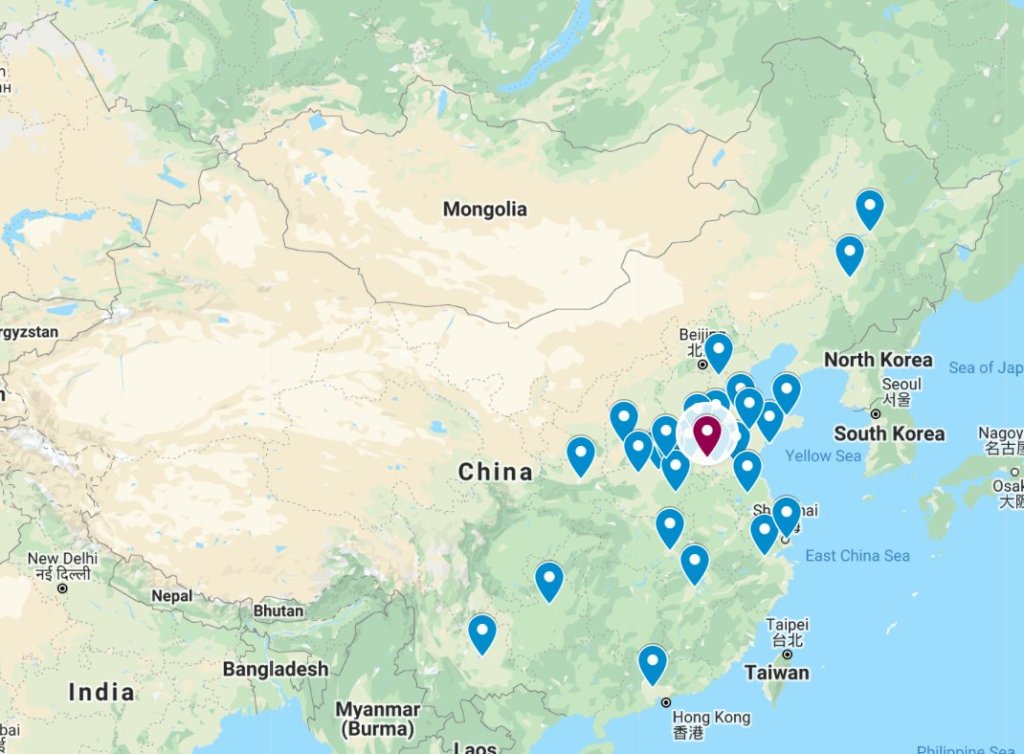
Thou shall not cavort like Zany Portuguese Sardines
By Smut Clyde
Here are some frames from a computer-animated version of Star Wars IV, plotted with an old line-printer (that’s what we did for entertainment in the late 1970s). The Death Star down in each frame’s quadrant Q3 is shooting out bolts of planet-smashing energy to the right through Quadrant Q4, while disciplined flotillas of Rebel Alliance X-Wing starfighters are swooping down through Q1 and Q2.
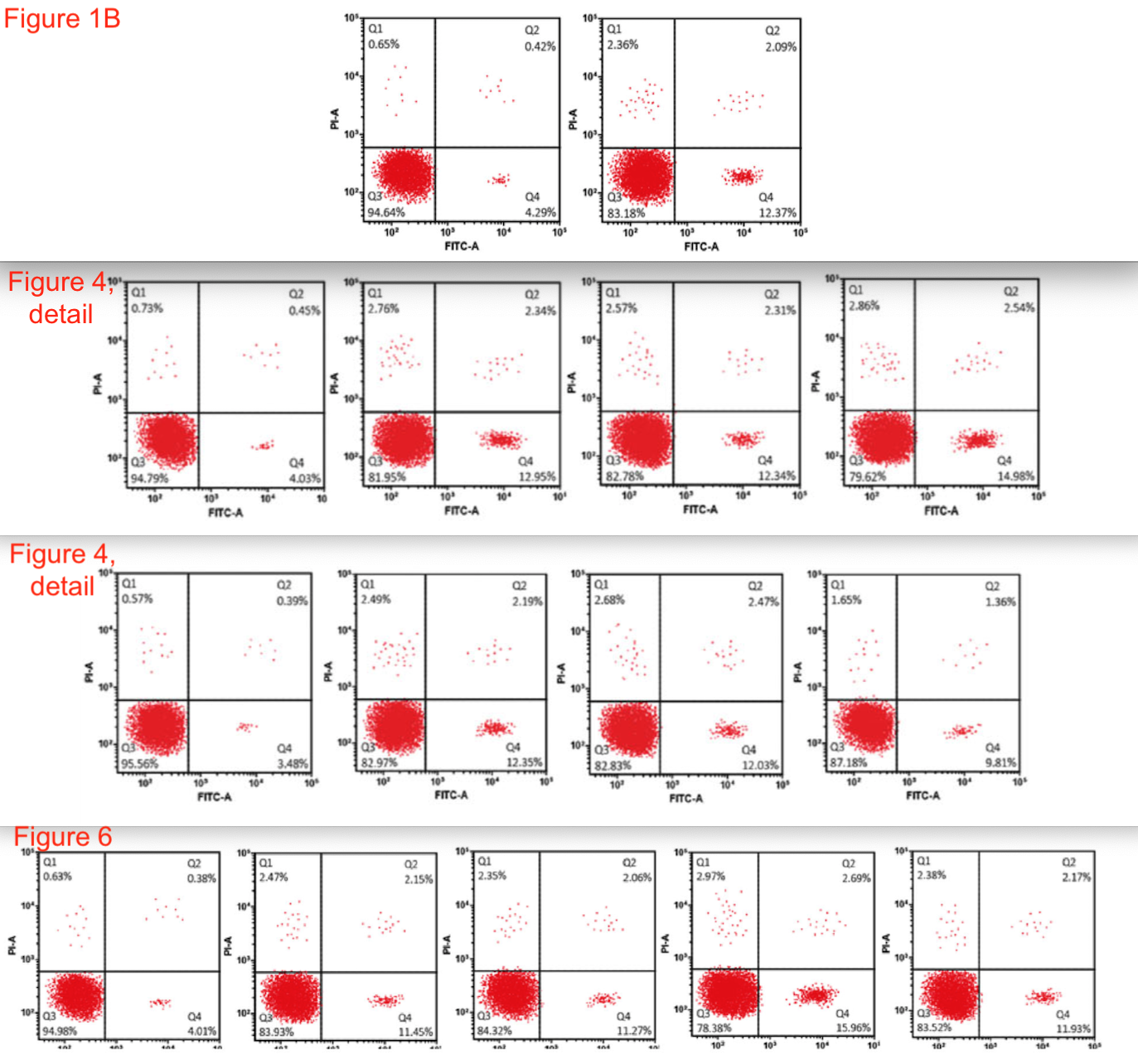
No, I made that up. These hairballs are purportedly FACS scatterplots where each dot is a cell, located by its surface-protein measurements: Figures from Tang et al. (2020) [11]. Surprisingly many cells yielded identical values in these independent experiments!
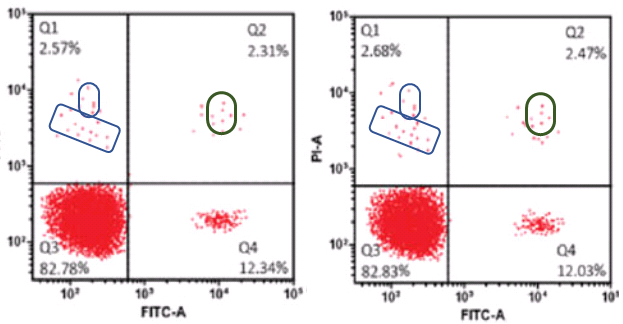
Other papers have reported further frames from the animation, overlapping in the same way. Fig 2 from Ren, Xu & Xu (2019) [6]:

Figures 2E and 2F from Xiao and Tian (2019) [8]:

What to make of this phenomenon? Perhaps these Western Blots from the same papers will assist in the search for an explanation.
When blobs of protein are formed on an electrophoresis gel, blotted onto a membrane and then picked out with antibodies, they can take many forms and shapes, depending on the distortions as they were force-marched across the gel… depending also on their shape when they were streaked out onto the starting-line. They can bunch up as they travel, or spread out sideways into neighbouring lanes, also the spaces between blobs vary. But they should not cavort like Zany Portuguese Sardines.

Thus skepticism is understandable when one encounters Figures where the lane spacing is constant and bands of all molecular weights are random but interchangeable morphological mixtures. Especially when the background texture is identical when emphasised by increasing the contrast; not only between bands but between Figures, and even between papers… manuscripts from non-overlapping teams of researchers, at unconnected hospitals and research centres from far-flung provinces in China.
Indigofera Tanganyikensis reported the first two instances of this phenomenon (Liu et al, 2019 [13]; Liu et al., 2020 [14]). Then Clone Ranger Elisabeth Bik (a.k.a. Obik-wan Kenobik) joined the chase. Currently they have flagged over 30 of these sardine scrapbooks in PubPeer threads, too many to list here so TigerBB8 and I scraped off the details and arranged them into a spreadsheet. Most author-names are unique although a few research teams have been back for a second bite of the cherry.
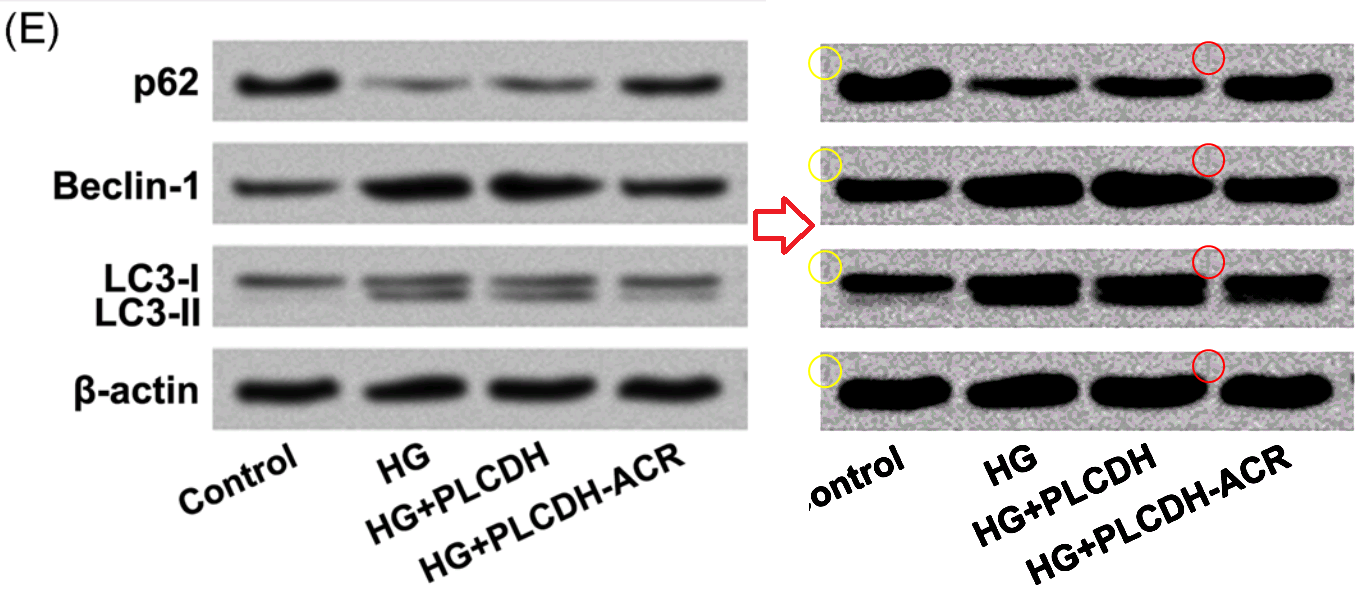
In theory the corresponding authors of each paper have been notified and invited to join the discussion of their work (an automagic feature of the PubPeer software), though no-one has shown up yet. In some cases the invitation may not have reached the authors, due to their choice of Gmail e-addresses, which are no longer accessible in mainland China.
- BrendaWillingham12192@gmail.com (Huang & Jin, 2018 [1])
- nancycook4925@gmail.com (Ma et al., 2018 [2])
- marildivisio25318@gmail.com (Chen et al., 2018 [4])
- RosettajKirkland3814@gmail.com (Zhang et al. 2018 [5])
- CaseyPeiffer8311@gmail.com (Zhang & Liu, 2019 [10])
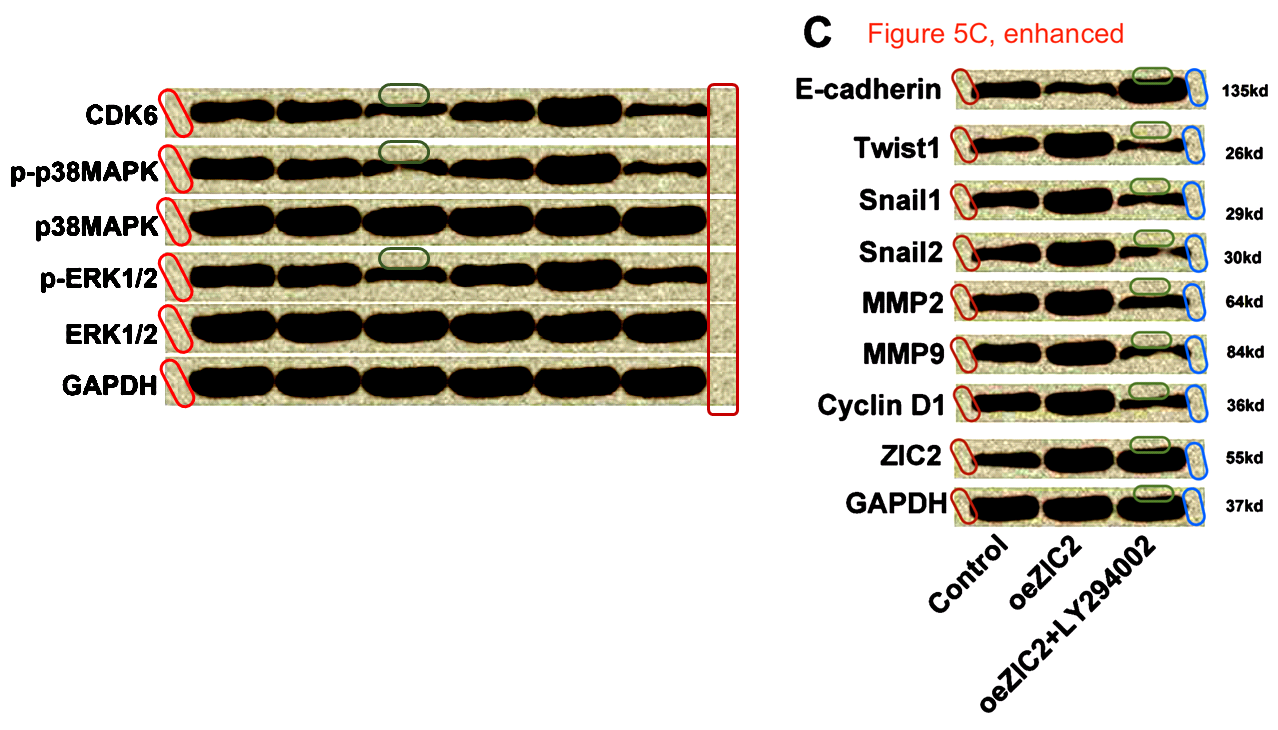
Now I am in no position to criticise anyone for adopting a playful pseudonym for correspondence, but these are not as academic as I would expect. The sources of the nyms are not obvious, apart from Casey Peiffer, who is a 9/11 Truther of some renown. At any rate the journal has evidently managed to stay in contact with whoever submitted them. This is an improvement on another early example in this tradition, Liu et al. (2017) [3], which was retracted when the editors could not contact the authors for the final authorisation. Not because of this:
The topics of these studies tend to conform to a template, helpfully summarised by Dr Bik in Mad-Libs format.

Phytochemicals from the materia medica of Traditional Chinese Medicine are common — Astrogaloside, Baicalein, Salidroside. I begin to wonder if there are any TCM-approved phytochemicals which don’t inhibit the proliferation and migration of medulloblastoma Daoy cells, in the hands of staff from Jining #1 People’s Hospital.

The majority of papers appeared in the Journal of Cellular Biochemistry from the Wiley stable, though not exclusively so (Biomedicine & Pharmacotherapy features as well, and Artificial Cells Nanomedicine and Biotechnology, and a few others). This may change. I would not be surprised if the PubPeer commentariat simply focussed on recent issues of J.Cell.Biochem. first, so we should not succumb to Selection Bias.
J.Cell.Biochem. has become popular among China-based molecular-biology researchers as an outlet for their work, and has a respectable Citations Index of 3.448 (though how much of that citational credit flows in from other journals remains to be seen). Despite this, my initial hope that the editors would consult experts to review submissions has been dispelled by their blithe acceptance of the egregious images above. Perhaps the peer-reviewers and contributors are collectively engaged in a Post-Modern project of redefining what Western Blots and FACS plots should look like, forging new expectations and conventions.
Two papers featured what purport to be Transwell Invasion Assays, while more closely resembling exercises in fumage and collage; the reviewers also thought these were fine (Zhang et al, 2019 [7]; Zhuang, Liu & Wu, 2019 [9]). Despite non-overlapping author lists, the images of both papers were built from a single small repertoire of fumage motifs.
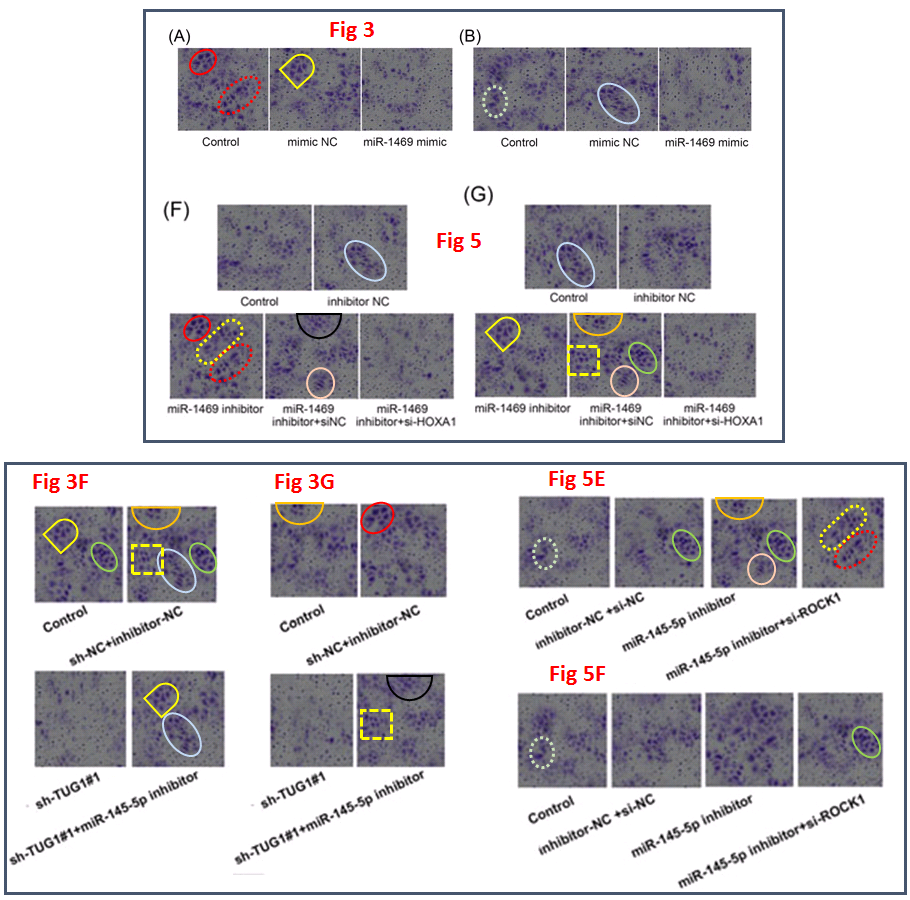
Notably, both papers included more frames from the Death Star animation, which is why they are included here despite the absence of zany-sardine Western Blots.
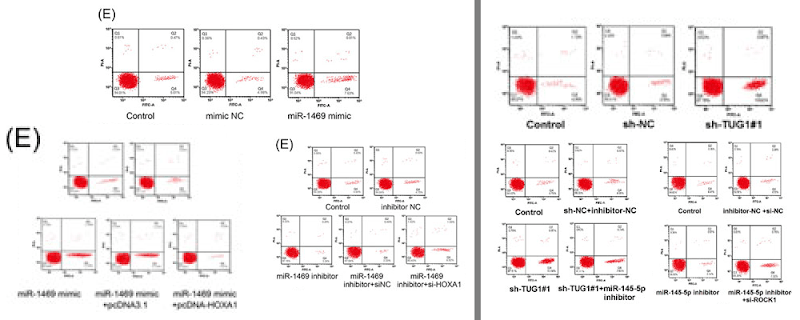
Elsewhere the reviewers signed off on this Declaration of Data Availability, puzzling in its uncertainty: “The data set(s) supporting the conclusions of this article is(are) included within the article” (Liu et al., 2020 [12]).

The article contained no raw data, lacking even the number of repetitions behind the graphs, though the statement could still be true if in fact the data sets don’t exist. Or if they exist but contradict the conclusions.
Setting the journal aside, the sources of these papers are not geographically diverse. The current list shows a concentration in Shandong Province, in Jining and Qingdao and a few other cities. Changchun, in Jilin Province, is a smaller hotspot. Those two groups trying TCM on medulloblastoma at the Department of Paediatrics, Jining No. 1 People’s Hospital seem to be working independently; they should get in touch and coordinate their efforts. [4], a.k.a. marildivisio25318, I’d like you to meet [5], a.k.a. RosettajKirkland3814… but maybe you have already met.

All this has a parsimonious explanation in a policy in China’s medical sector, whereby promotion for everyone — clinicians and researchers alike — depends on publishing academic papers. Of course the average overworked doctor has neither the time, the training nor the resources to apply transfection technology to the interaction between triptolide, microRNA-1462 and JNK pathways in osteosarcoma, then write it up for publication, so they pay someone else to make it all up. And if you were familiar with the conventions of the academic genre, and had the software for plotting made-up statistics, wouldn’t you take advantage of this market opportunity by setting up a papermill?
Presumably the persons behind this service are relying on word-of-mouth to advertise their service, hence the geographical concentration. They have friends or members outside the mainland, allowing them to access the bogus Gmail accounts and keep in touch with the journal. One can speculate that there is someone within the editorial structure of J.Cell.Biochem. who is in on the deal and has suborned the peer-review process to ensure that manuscripts are only sent to friendly or fictitious reviewers (the same deduction might also follow for other journals; we await further developments).
Are there any victims in this curious market-driven ecology, where the nominal authors get the CV-stuffers they need and the actual authors get paid? Opinions are divided. There is the danger that genuine biomedical researchers in China might be disadvantaged if they foolishly published in J.Cell.Biochem., only to have their work dismissed and ignored. It would be helpful if the journal introduced some sort of flag to let readers know which of their articles are based on real experiments and which ones are information-free fabrications, forged to meet contractual / promotional obligation.
Sources:
- “ZIC2 promotes viability and invasion of human osteosarcoma cells by suppressing SHIP2 expression and activating PI3K/AKT pathways”, Shuaihao Huang, Anmin Jin. Journal of Cellular Biochemistry (2018), doi: 10.1002/jcb.26387 [PubPeer].
- “MicroRNA-29a inhibits proliferation and motility of schwannoma cells by targeting CDK6”, Ji Ma, Tengfei Li, Huifeng Yuan, Xinwei Han, Shaofeng Shui, Dong Guo, Lei Yan. Journal of Cellular Biochemistry (2018) doi: 10.1002/jcb.26426 [PubPeer].
- “Retraction : HCFU inhibits cervical cancer cells growth and metastasis by inactivating Wnt/β‐catenin pathway”, Ping Liu, Shuying Ma, Hua Liu, Huazhen Han, Shanshan Wang, Journal of Cellular Biochemistry (2017) doi: 10.1002/jcb.26570 [PubPeer].
- “Ginsenoside Rh2 inhibits proliferation and migration of medulloblastoma Daoy by down-regulation of microRNA-31”, Yan Chen, Hong Shang, Shunli Zhang, Xiaohong Zhang. Journal of Cellular Biochemistry (2018) doi: 10.1002/jcb.26716 [PubPeer].
- “Triptolide inhibits the proliferation and migration of medulloblastoma Daoy cells by upregulation of microRNA-138”, Haifang Zhang, Hui Li, Zhenguo Liu, Ang Ge, Enyu Guo, Shuxia Liu, Zhiping Chen. Journal of Cellular Biochemistry (2018) doi: 10.1002/jcb.27307 [PubPeer].
- “Salidroside represses proliferation, migration and invasion of human lung cancer cells through AKT and MEK/ERK signal pathway”, Mei Ren, Wenjing Xu, Tao Xu Artificial Cells Nanomedicine & Biotechnology (2019) doi: 10.1080/21691401.2019.1584566 [PubPeer].
- “Downregulation of microRNA-1469 promotes the development of breast cancer via targeting HOXA1 and activating PTEN/PI3K/AKT and Wnt/β-catenin pathways”, Yonghui Zhang, Jing Fang, Hongmeng Zhao, Yue Yu, Xuchen Cao, Bin Zhang. Journal of Cellular Biochemistry (2019) doi: 10.1002/jcb.27786 [PubPeer].
- “Knockdown of long noncoding RNA HOTAIR inhibits cell growth of human lymphoma cells by upregulation of miR‐148b”, Xianxian Zhao, Xiaoyan Tian Journal of Cellular Biochemistry (2019) doi: 10.1002/jcb.28500 [PubPeer].
- “Upregulation of long noncoding RNA TUG1 contributes to the development of laryngocarcinoma by targeting miR‐145‐5p/ROCK1 axis”, Shenfa Zhuang, Fengxian Liu, Pingping Wu. Journal of Cellular Biochemistry (2019) doi: 10.1002/jcb.28614 [PubPeer].
- “Sapylin inhibits lung cancer cell proliferation and promotes apoptosis by attenuating PI3K/AKT signaling”, Lin Zhang, Benhong Liu Journal of Cellular Biochemistry (2019) doi: 10.1002/jcb.28729 [PubPeer].
- “Long noncoding RNA MEG3 deteriorates inflammatory damage by downregulating microRNA‐101a”, Shouyi Tang, Junxia Han, Hui Jiao, Jingna Si, Yingying Liu, Jinlong Wang Journal of Cellular Biochemistry (2020) doi: 10.1002/jcb.29415 [PubPeer].
- “Silence of cZNF292 suppresses the growth, migration, and invasion of human esophageal cancer Eca‐109 cells via upregulating miR‐206”, Zengjia Liu, Guiju Hu, Yan Zhao, Zuorun Xiao, Mingzhe Yan, Mei Ren. Journal of Cellular Biochemistry (2020) doi: 10.1002/jcb.29458 [PubPeer].
- “Circular RNA ACR relieves high glucose‐aroused RSC96 cell apoptosis and autophagy via declining microRNA‐145‐3p”, Ying Liu, Xiaoqing Chen, Jingjing Yao, Jing Kang Journal of Cellular Biochemistry (2019) doi: 10.1002/jcb.29568 [PubPeer].
- “Intermedin attenuates cardiomyocytes hypoxia‐injury through upregulating long noncoding RNA MALAT1”, Long Liu, Haiming Xu, Jingze Zhang, Liquan Yin, Qini Zhao Journal of Cellular Biochemistry (2020) doi: 10.1002/jcb.29642 [PubPeer].
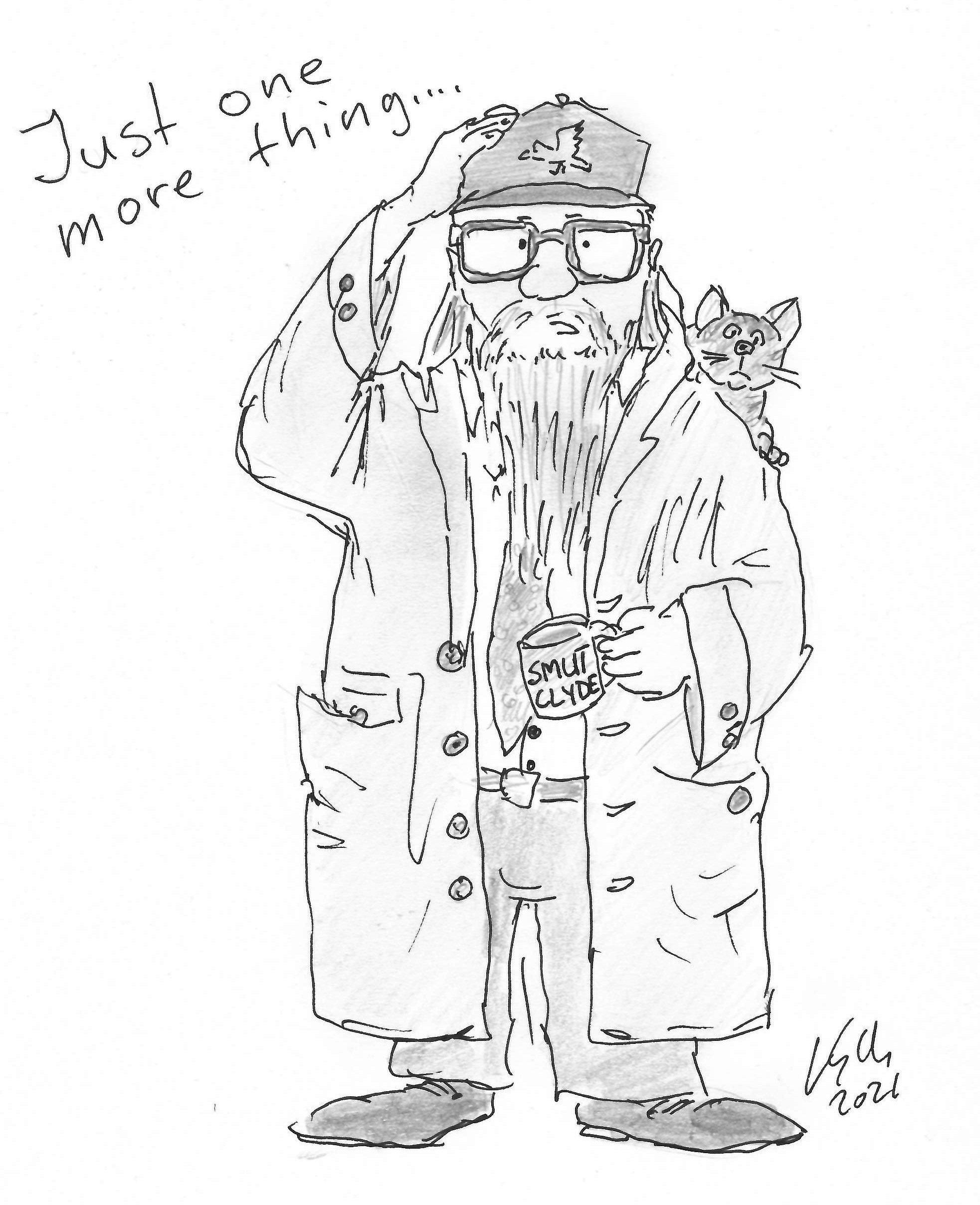
Donate to Smut Clyde!
If you liked Smut Clyde’s work, you can leave here a small tip of 10 NZD (USD 7). Or several of small tips, just increase the amount as you like (2x=NZD 20; 5x=NZD 50). Your donation will go straight to Smut Clyde’s beer fund.
NZ$10.00



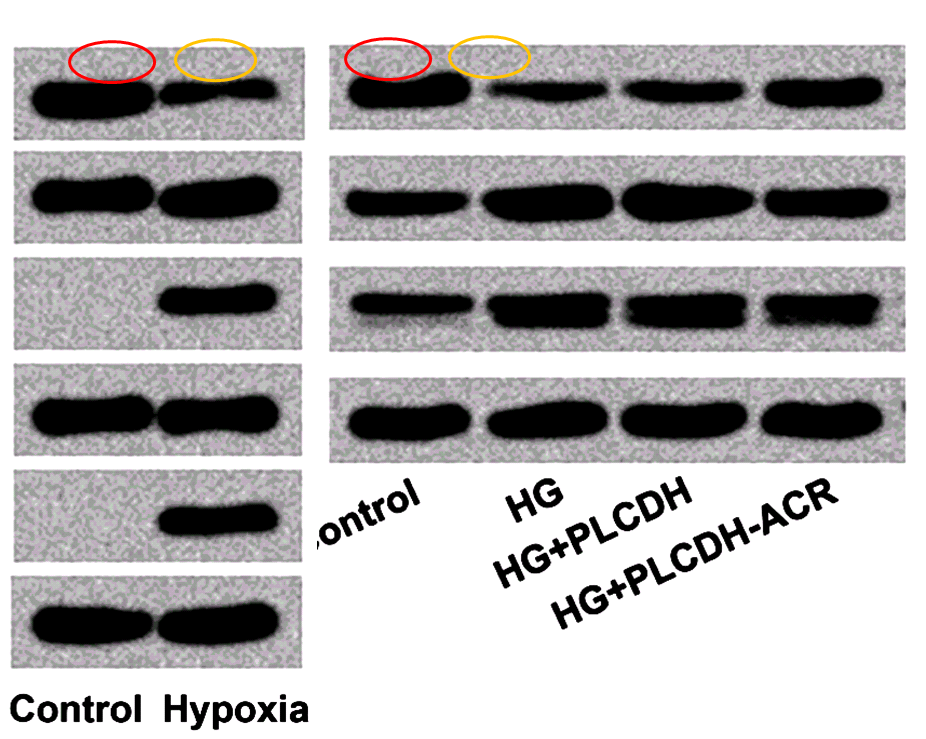

During a recent scientific visit to China I discovered that all serious Chinese scientists know how to access Google from inside China. You wrote “they have friends or members outside the mainland, allowing them to access the bogus Gmail accounts and keep in touch with the journal” but I don’t think they need that. Hong Kong and Taiwan provide nice internet bridges for homegrown vpn’s. But indeed, there is a huge Chinese diaspora in academia all over the world and they naturally keep in touch with their friends (e.g. fellow alumini of the same Chinese university) back home, helping one another out, in both directions. I suppose that the Chinese business world is the same as the Chinese academic world. Neither business, nor science, is stopped by internet walls; though everyone complains what a nuisance it is.
LikeLiked by 1 person
I don’t deny that some Chinese can access Google service from inside China, including those you referred as “serious Chinese scientists”, but they must be serious enough risking being detained by police simply for accessing Gmail using a VPN, or they must be privileged (enough) to have been assigned a direct port going outside the country or with special permission of using VPN to leap over the Great Firewall. If you have been “serious” enough communicating with your “serious” Chinese scientist friends, you would have known what 翻墙 (leap over a wall) means. If not, simply ask them if they were practicing 翻墙 while accessing Gmail.
Facebook and Twitter do not exist within the territory of mainland China, neither does Google. But I bet you have seen Twitter users who apparently are from inside China, such as People’s daily, CNTV, etc. Hope that explains what I mean by “privileged”.
Authors of the papers summarized in this article are physicians in regional hospitals. They are not those born more equal than others and very unlikely to have a direct port accessing external web service like Google. Even if they were somehow able to access Gmail one way or another, it is very odd for a Chinese doctor to register his/her email account like nancycook, I bet 90% of them never understand Nancy Cook is a proper name.
FYI. I confirmed with multiple friends in Beijing, Tianjin, Henan, and Shandong that Gmail was only accessible through a VPN. To make my confirmation “serious” enough, I contacted one serious scientist in Chinese Academy of Science (CAS), and she confirmed the same thing for me. Even at the highest level research institution like CAS, which by the way the most privileged, she cannot access Gmail without using special means such as a VPN.
LikeLike
I work at a research institute directly under a provincial Academy of Science in China. I hardly know anyone in my department who don’t use a VPN to access at least google scholar when needed, though for most other services they use Chinese alternatives. My boss doesn’t, as far as I know, but everyone else does. So do virtually all my friends here and my wife’s work colleagues.
Of course, they don’t say so openly.
So no, it’s not as bad as people depict it.
LikeLike
My general rule of thumb: if the paper has all authors with Chinese names (think Chong, Zhong, etc) from a “university” in China (think “state key”), I don’t bother reading the paper. Its probably wrong, and not worth the time.
IMO there are cultural differences at play. In the west, most value the sovereignty of the individual and the truth. In China, not so much. More about getting ahead at any cost. Just my opinion.
LikeLiked by 1 person
My general rule of thumb: if the paper has 60% plus authors with Italian names I don’t bother reading the paper. Its probably wrong, and not worth the time.
LikeLike
I’m quite tired of your comments man… Is it possible for you to be more creative here? OK, everybody here finds out that western people are OK and Chinese, Blacks, Indians, and whatever you call them are just bad people. I mean, if you converted your commenting efforts into something more useful for your career, I bet you were a full professor now instead of being a poor post doc.
By the way, your ignorance of Chinese or whatever crappy junks that are out there don’t make them disappear. Those junks are just there and they already delivered the intended benefit for their authors even if those craps will be retracted. So stop this gesture of being the most glorious and honest researcher in the world and just please remember how miserable your life is as a poor old under paid post doc and do something about it to get out of this shit…
LikeLike
Thank you, Mike!
LikeLike
If my comments further antagonize a confessed cheater like you, Mike, my day has been made.
I love how you are always pointing out someones status (mine, post-doc), and put them down if they are lower in the hierarchy. Again, my observation has been some (not all) non-western cultures have a tendency to like to do this, to suggest people low down on the ladder are inferior or subhuman. Maybe for this reason these cultures want to get ahead at any cost.
LikeLike
I suspect that there would be no difference if the current gubblements of Britain and the US enacted an edict that medical professionals needed to publish research papers in proper science journals before they could be promoted, then English-only papermills would lose no time in filling the market gap.
LikeLike
Well. https://twitter.com/essaysolutions_/status/1221036049981497344?s=19
LikeLike
My general rule of thumb: assume that everything [in the peer-reviewed literature, regardless of country of origin or journal] is wrong until proven right.
LikeLiked by 1 person
You usually cannot prove that something is right. Science is mostly about the (potentially falsifiable) things that survive all your (reasonable) attempts at trying to prove them wrong…
LikeLike
I should belatedly credit Pubpeer contributor ‘Daniellia Oliveri’ for first noticing the Death-Star FACS style four months ago.
https://pubpeer.com/publications/8BCB28DE99565D0553717C1828D694
It is an unenviable situation for Chinese medical clinicians, who have to pay for these productions just to do the job they trained for.
But at the same time, the papermill productions should be labelled somehow, so that people don’t mistake them for real observations on herbal extracts and cancer, and so that actual researchers in China don’t become disadvantaged by having their work dismissed.
LikeLike
In Sport, athletes from Russia were banned from participating due to state driven doping. If the Chinese government is not cleaning up this mess pretty soon, Chinese scientist should be banned from publishing in international journals. Ideally.
However, most important for the publishers is the profit.
Therefore, I will again argue that journal indexing in PubMed should be much more strict and we need an international agency with power to get the science at the right track again.
LikeLike
Good idea. Something similar to the Word Doping Agency, but focused on science?
LikeLike
PubMed policing science? The phrase cat-flap in an elephant house comes to mind.
LikeLike
These email adresses remind me of Luming Zhang
https://forbetterscience.com/2019/06/24/patriotism-and-the-many-secret-identities-of-luming-zhang/.
LikeLike
I was just thinking the other day about Chao Xiong – or rather, Luming Zhang using “xiongchao1778@126.com” as a working address – and how that crazy story developed
LikeLike
Crap researchers pay crap journals to publish crap, and in the process they make a mockery of peer review, citations and the concept of scientific publication in general. Long ago one of my profs told me that the most important instrument a scientist needs is a finely-tuned bullshit detector, and I have come up with an assortment of methods for ignoring this garbage, its originators and purveyors. Screening by originating nations actually works quite well, and if the minority of legitimate contributors suffer, that is the price they have to pay for letting the problem continue. It is to be hoped that we will soon have AI systems capable of doing the job of quarantining these half-bright wankers in their own corner of what they imagine is the scientific universe. Maybe we can even construct some virtual reality schemes to fool them into thinking they are doing something worthwhile.
LikeLike
“Screening by originating nations actually works quite well, and if the minority of legitimate contributors suffer, that is the price they have to pay for letting the problem continue.”
With all due respect, I think this is racist shite.
LikeLike
Profiling, sadly, works, but the social justice warriors will call it racist in a heartbeat. Of course these individuals are probably removed from the realities of the argument, or somehow benefit from the social justice stance.
LikeLiked by 1 person
In science, time is worth much more than money. If a nation tolerates and in many cases actively promotes fakery for everything from data to reagents, why should I waste my precious time considering or acknowledging the outputs of its researchers? They are shoveling shit while I am trying to mine gold. Only the laziest of intellects could call that racist. To save you time, I’m also Hitler.
LikeLiked by 1 person
“To save you time, I´m also Hitler.”
Ah, ok. That´s why you spare the Italians.
LikeLike
I am amazed by the frequency of data duplications and manipulation in recent papers in many different journals. A quick look at the newest ones in Journal of Cellular Physiology (Wiley), the sister journal of Journal of Cellular Biochemistry, which is highly involved in the Chinese paper mill scam), I found several train wrecks:
Just look at two examples:
https://pubpeer.com/publications/6127B25FF4F299FB53B6E567316D70#1
https://pubpeer.com/publications/BCDCB9AF15F31B599E55C543E853BD#1
The manipulations are so obvious and it is clear that the peer-reviewing system in this journal is totally cracked.
It is a complete tragedy that public funds are spent on publishing false data and that public resources in addition are spent on paying the publisher for access to this misinformation!
Researchers, please engage! Contact NIH and the US National Library of Medicine and ask for quality control in their journal indexing. Ask your research institution why they support publishers that are spreading misinformation and destroying the science. Report all research misconduct.
A paradigm shift is needed to rebuild trust and reproducibility in science. A stringent quality control at the public indexing of scientific literature and the establishing of an independent international anti-research misconduct agency could be part of the solution.
LikeLiked by 1 person
I have also noticed that both Journal of Cellular Physiology (Wiley),and the sister journal of Journal of Cellular Biochemistry, have something like 3000-4000 papers per issue. How is that possible? How can an issue be that big? My guess is that somebody took over these journals once they reached IF of about 4 and is now just publishing everything for a fee. Next IF will drop drastically, for sure, and these journals will be dead. But then they might be growing already other journals for the same purpose. And its not only China, note in some of these issues same Iranian author publishing 20 reviews, how can that be?
LikeLike
Pingback: O's digest al tempo del colera - Ocasapiens - Blog - Repubblica.it
Two papers featured what purport to be Transwell Invasion Assays, while more closely resembling exercises in fumage and collage; the reviewers also thought these were fine (Zhang et al, 2019 [7]; Zhuang, Liu & Wu, 2019 [9]). Despite non-overlapping author lists, the images of both papers were built from a single small repertoire of fumage motifs.
We now have four of these papers with fake migration / invasion images, assembled from the same repertoire of motifs.. None of them are really convincing.
Yin et al. (2018): https://pubpeer.com/publications/FD8D63B5205D93DDF323E01CAA48BA
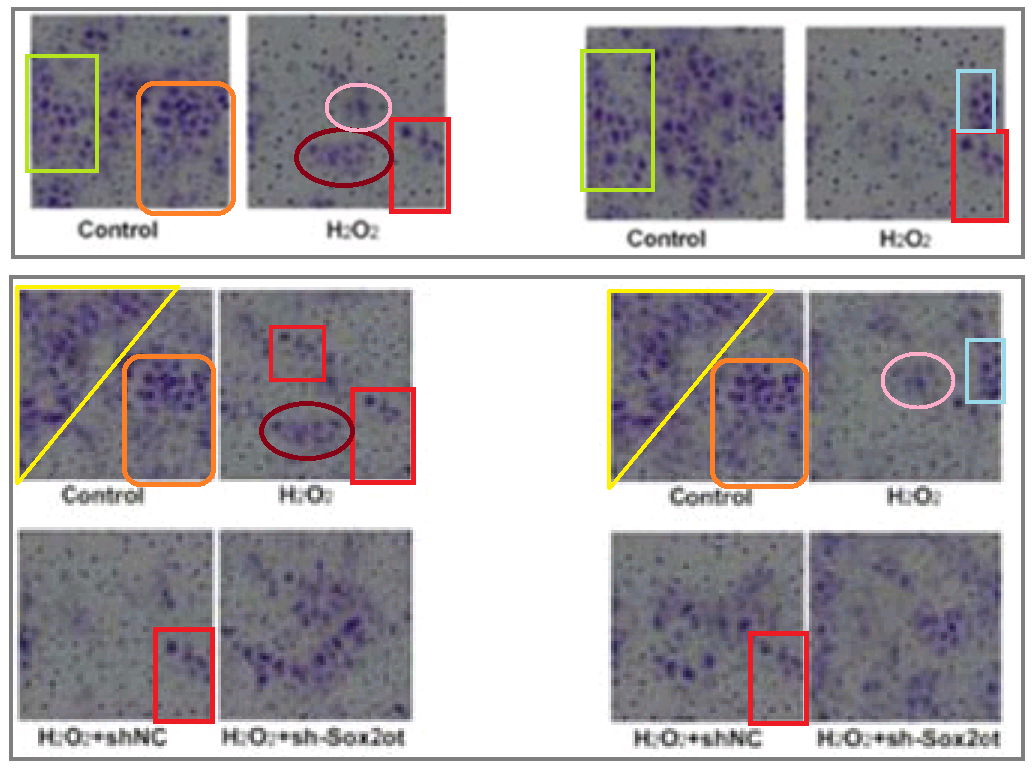
Kong et al (2019): https://pubpeer.com/publications/79864673D07CB387527C4270A61510

LikeLike
The workshop evidently has access to a small stock of legitimate Transwell invasion / migration images, so these feature in some of the productions for added verisimilitude. Until the stock runs out and they have to be reused.
This complicated stamp collection is my attempt to show the duplications, triplications and quadruplications between Lv et al. (2019).https://pubpeer.com/publications/AA44FFE1D09AB6DA19033EB378EAED
Yi et al. (2019) https://pubpeer.com/publications/769DDF34E0C6CE6F7C8A354FE23371
and Sun et al (2019) https://pubpeer.com/publications/BA06E02792AEB2A26D3F72882B5545.
Images are triplicated just within Sun et al. The journal in question, “Artificial Cells, Nanomedicine, and Biotechnology”, is pay-to-publish Open Access, and does not seem to bother with peer reviewers.
LikeLike
And then a fourth paper turns up with the same images relabelled once again!
https://pubpeer.com/publications/AA85EF9A9B9856141E4C18A29B08AA
LikeLike
With ~260 productions noticed so far, there are enough data to spot sub-styles within the fake blots. Clearly we are dealing with a whole studio rather than a one-man fake factory, so I could speculate that these stylistic tweaks are coming from different desks.
Anyway, in one substyle the protein blobs look more like tadpoles than zany sardines… or old-school telephone handpieces… or well-chewed dog-bones… but airbrushed to glossy perfection.
Five examples so far: https://pubpeer.com/publications/769DDF34E0C6CE6F7C8A354FE23371#3
LikeLike
Two cases so far have shown up in “BMC Cancer”, which does have peer review, and sometimes even makes available the reviewers’ reports.
For “Ras-ERK1/2 signaling contributes to the development of colorectal cancer via regulating H3K9ac” (Tian et al. 2018), a reviewer asked for “Representative pictures for transwell migration and soft-agar colony formation assays”, and these were duly added in the second version. The papermill even handles revisions! I am impressed.
The reviewers could not have been aware that the same images of migration and colony formation were also used in another paper, Huang & Jin (2018), for completely different cells and different treatments.
There are no authors in common, and why should there be?
LikeLike
Regarding the ads for selling papers:
I can’t be sure if those manuscripts were all ‘artificially’ created or not. Some manuscripts put for sale may be legit papers but their authors don’t seem mind adding a spot or two for some extra cash.
Also, this screenshot Leonid posted was originally posted by an anonymous ppl (namely ‘mob’ per a Dr. Martinez on twitter). I went to the same site yesterday (Feb. 05), there were apparently less such ads but still some info suggesting similar business was still going on and everyone seemed used to that. I saw the following post (red is my rough translation for the dialog)

LikeLike
Here’s an interesting case: the Elsevier journal International Journal of Biological Macromolecules retracted a papermill production, though no reasons were provided.
“This article has been withdrawn at the request of the author(s) and/or editor. The Publisher apologizes for any inconvenience this may cause.”
The papermill simply sent it to Artificial Cells Nanomedicine and Biotechnology instead.
“Editorial Note:
We, the Editor and Publisher, are aware that this article “Long non-coding RNA H19 promotes angiogenesis in microvascular endothelial cells by down-regulating miR-181a”, was previously published in the International Journal of Biological Macromolecules in August 2018. After publication the authors noticed significant errors in their results, and in agreement with the editors at International Journal of Biological Macromolecules, withdrew the article. The authors revised the study to address the errors and submitted to Artificial Cells, Nanomedicine and Biotechnology, where the article was fully peer reviewed and accepted for publication by the editors. In the interests of providing our readers with full transparency on this issue we have provided the link to the withdrawal statement”.
I can’t see any difference between the original and revised versions – both have the same fabricated Western-Blot sardines.
But the editors of Artificial Cells accept the papermill’s explanations, and I am sure they are not motivated entirely by the prospect of Article Processing Charges.
LikeLike
Rather than boycotting papers from a country, one can
Check paper on Pubpeer – Read / Bin decision.
If Read then score,
2. Check country of origin, including whether e-mail addresses of authors are consistent with known restrictions, score No 0, Yes 1
2. Check journal, is it dubious, score dubious 0 or OK 1.
3. Does journal have a rubout policy of dealing with fraud? Score 0 or 1.
4. How much of original data available ? None = 0, all = 1, intervening value allowed.
Set your bar for Read somewhere between 1 and 4 depending on level of uncertainty you wish to entertain.
Lower the score, spend a lot more time checking the figures.
If Bin then do not read, or if have time/inclination/skills or need entertainment, Read and contribute to Pubpeer discussion.
LikeLike
Pingback: Wetenschap in China onbetrouwbaar (?) - Geleerd uitschotGeleerd uitschot
The current version of the spreadsheet shows the most enthusiastic customers of the papermill to be
Yang Wang, of Department of Orthopaedics, China‐Japan Union Hospital of Jilin University. Sometimes working with colleagues from The Second Hospital of Jilin University. 12 papers
Dexin Yin, of Department of Vascular Surgery China, Japan Union Hospital of Jilin University. Seven papers.
4th equal. Jingzhe Zhang, of Department of Respiratory, China-Japan Union Hospital of Jilin University. Six papers.
4th equal. Meihan Liu, of Department of Respiratory China-Japan Union Hospital of Jilin University. Six papers.
4th equal. Chao Zhang, of Department of Orthopaedics, China‐Japan Union Hospital of Jilin University. But one or two of those may belong to a different Chao Zhang.
9th equal. Dajun Sun, of Department of Vascular Surgery, China-Japan Union Hospital of Jilin University. Five papers.
9th equal. Daliang Kong, of Department of Orthopedics, China-Japan Union Hospital of Jilin University. Five papers.
9th equal. Haiming Xu, of Department of Cardiovascular Internal Medicine, China-Japan Union Hospital of Jilin University. Five papers.
9th equal. Jia Liu, of Department of Anesthesiology, The Affiliated Hospital of Qingdao University. Five papers.
9th equal. Rui Jiang, of Department of Orthopedics, China-Japan Union Hospital of Jilin University. Five papers.
9th equal. Weixuan Sun, of Department of Vascular Surgery, China-Japan Union Hospital of Jilin University. Five papers.
9th equal. Yaping Li, of Department of Vascular Surgery, China-Japan Union Hospital of Jilin University. Five papers.
Of course there is a lot of overlap and co-authorship going on here. But Jilin University seems to have become particularly dependent on this papermill for staff promotions.
LikeLike